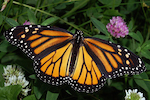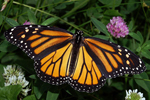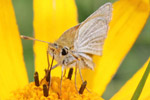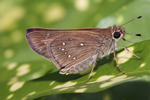Monarch butterfly population is second lowest on record

The shrinking of the migrating monarch butterfly population. Image by: WWF.
The world’s migrating monarch butterfly population has bounced back slightly from its record low last year, but the new numbers are still the second smallest on record. According to WWF-Mexico and the Mexican government, butterflies covered 2.79 acres (1.13 hectares) in nine colonies this year in the Mexican forests where the insects overwinter. This is a 69 percent increase from last year’s nadir of just 1.65 acres (0.67 hectares), however, the new numbers remain hugely concerning.
“The population increase is welcome news, but the monarch must reach a much larger population size to be able to bounce back from ups and downs,” said researcher Tierra Curry with the Center for Biological Diversity, adding that “this much-loved butterfly still needs Endangered Species Act protection to ensure that it’s around for future generations.”
Last month, the U.S. Fish and Wildlife Service said it would consider adding the vanishing insect under the country’s Endangered Species Act. Currently, the monarch butterfly (Danaus plexippus) is not at risk of extinction, but its migration is. Monarch butterflies in the Eastern U.S. are famous for their epic migration spanning some 1,900 to 4,500 kilometers (1,200 to 2,800 miles) from Canada to the mountains of central Mexico every year. Each migration takes several monarch generations to complete, often three to four.
In the 1990s—when scientists first started counting the area filled by migrating monarch butterflies in Mexico—the overwintering habitat never dipped below 13 acres (five hectares). The largest population covered 44.95 acres (18.19 hectares) in 1993. But the trend over the last decade has been one of extensive decline, with various rises and falls.

Annual area of monarch butterflies overwintering in Mexico from 1993-2014. Image by: WWF.
A decade ago, conservationists were largely concerned with deforestation and illegal logging in Mexico’s overwintering forests. However, due to work by indigenous groups, locals, and the Mexican government that threat has been largely neutralized, at least for the time being. Today the biggest threat is the loss of food and habitat across the U.S. and Canada due to herbicides and increasingly intensified agriculture.
According to WWF, herbicide use in the U.S. for soy and corn killed off 58 percent of the country’s milkweed from 1999 to 2010, resulting in a monarch decline of 81 percent. The development of genetically modified crops has exacerbated the situation as these crops are resistant to the popular herbicide, Roundup. However, Roundup and other herbicides containing glyphosate decimate milkweed populations. Monarch butterfly caterpillars feed solely on milkweed, meaning the species requires a road of milkweed from Canada through Eastern and Central U.S. down to Mexico in order to survive. But agriculture policy in the last couple decades, especially in the U.S., has resulted in a massively fragmented milkweed route.
“The 2.79 acres occupied by monarchs this winter should serve as additional motivation for the leaders of Canada, Mexico, and the United States to translate the commitment they made in Mexico in February 2014, to concrete and immediate actions,” said Omar Vidal, Director General of WWF-Mexico. “It is crucial that we restore and protect the habitat of this iconic species in all three countries, but above all that we limit the use of herbicide and land conversion in the United States and maintain efforts to avoid deforestation in Mexico.”
Conservationists say that planting milkweed in gardens may benefit the monarch, however gardeners must plant they right variety of milkweed and make sure the milkweed hasn’t been coated with a popular insecticide in the neonicotinoid family. Research has shown that neonicotinoids may harm pollinators, such as bees and butterflies.
Monarch butterflies aren’t the only pollinators in trouble, many of the world’s pollinators have undergone drastic declines in recent decades. Experts point to possible impacts such as pesticides, habitat loss, and disease.
Related articles
|
‘Canary in the cornfield’: monarch butterfly may get threatened species status
(09/08/2014) Monarch butterflies were once a common sight throughout the North American heartland. But declines in milkweed – their caterpillars’ only source of food – have led to a 90 percent decline in monarch numbers. Now, the U.S. Fish and Wildlife Service is reviewing a petition that would grant the iconic species protection through the Endangered Species Act. |
|
U.S. citizens willing to spend billions to protect monarch butterflies
(04/03/2014) New research shows Americans are willing to pay for the protection of the ailing monarch butterfly, which is experiencing a steep decline in numbers. The study, published in Conservation Letters, found nearly three-quarters of those surveyed placed importance on conservation efforts for the iconic species. |
|
Migrating monarch butterflies hit shockingly low numbers
(01/31/2014) The monarch butterfly population overwintering in Mexico this year has hit its lowest numbers ever, according to WWF-Mexico. Monarch butterflies covered just 0.67 hectares in Mexico’s forest, a drop of 44 percent from 2012 already perilously low population. To put this in perspective the average monarch coverage from 1994-2014 was 6.39 or nearly ten times this year’s. For years conservationists feared that deforestation in Mexico would spell the end of the monarch migration, but now scientists say that agricultural and policy changes in the U.S. and Canada—including GMO crops and habitat loss—is strangling off one of the world’s great migrations. |
|
Zoo races to save extreme butterfly from extinction
(08/15/2013) In a large room that used to house aquatic mammals at the Minnesota Zoo, Erik Runquist holds up a vial and says, ‘Here are its eggs.’ I peer inside and see small specks, pale with a dot of brown at the top; they look like a single grain of cous cous or quinoa. Runquist explains that the brown on the top is the head cap of the larva, a fact that becomes more clear under a microscope when you can see the encased larva squirm. I’m looking at the eggs of a Poweshiek skipperling, a species that is more imperiled than pandas, tigers, or bluewhales. Once superabundant, only several hundred Poweshiek skipperlings may survive on Earth today and the eggs I’m looking at are the only ones in captivity. |
|
Florida declares two butterfly species extinct as pollinator crisis worsens
(08/01/2013) Conservationist’s faced a crushing blow last month as two butterfly species native to Florida were declared extinct. |
|
Habitat loss and pesticides causing decline in Europe’s butterflies
(07/31/2013) Europe’s grassland butterfly population has plummeted in the past two decades, new research published on Tuesday shows, with a near halving in the numbers of key species since 1990. |



















